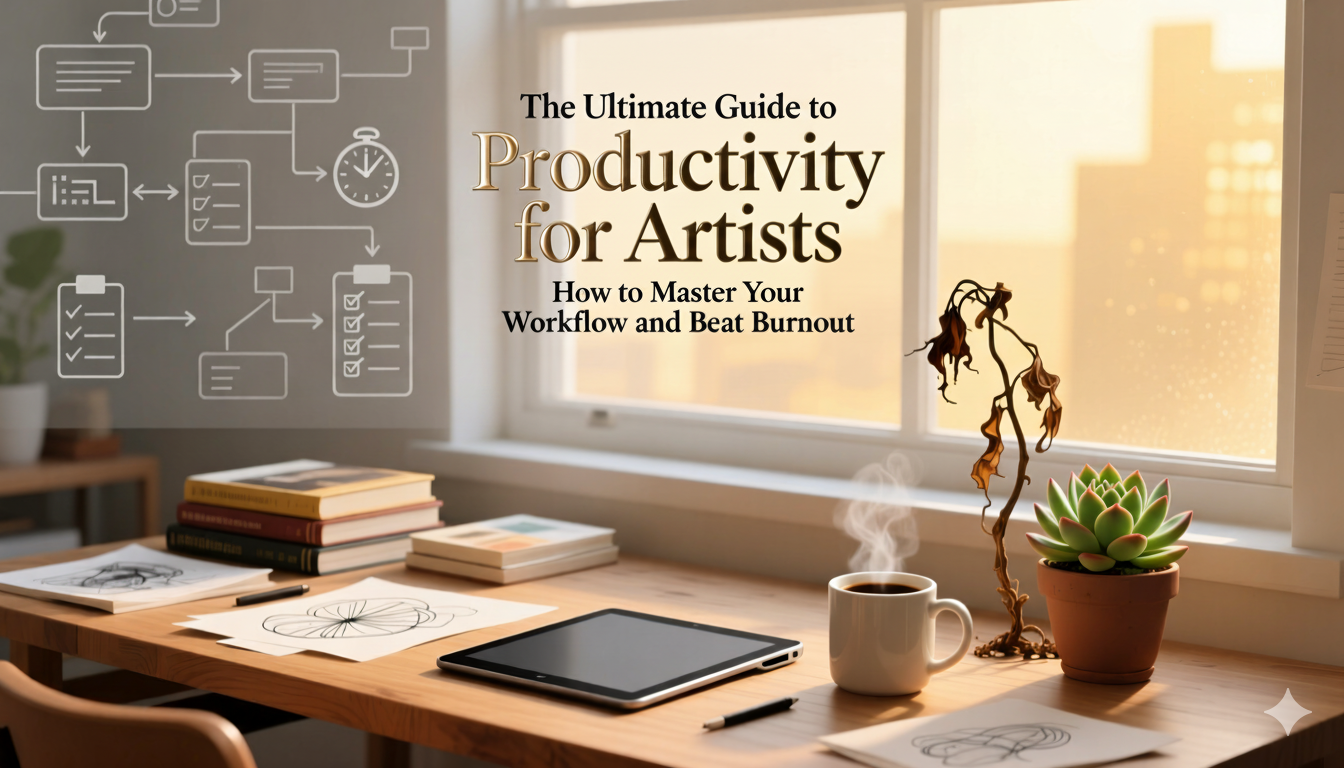Let’s be honest—being an artist isn’t just about waiting for inspiration to strike while you stare at a blank canvas. If you’re serious about your craft, productivity for artists is just as important as talent. Whether you’re juggling commissions, building your portfolio, or trying to start an art business in 2025, learning how to work smarter (not just harder) can transform your creative practice from chaotic to consistent.
Key Takeaways
- Productivity for artists requires balancing creative energy management with practical time management techniques
- Setting up an optimized studio environment and establishing clear goals creates a foundation for consistent creative output
- Time management methods like the Pomodoro Technique and time blocking help artists maintain focus without sacrificing creativity
- Building daily creative habits and protecting your mental health are essential for avoiding burnout
- The right digital tools can streamline your workflow, from managing commissions to organizing inspiration
- Overcoming creative blocks is a skill that can be developed through specific strategies and mindset shifts
Why Productivity for Artists Is Different
Here’s something most productivity gurus don’t understand: artists aren’t just managing time—we’re managing creative energy. You can’t schedule inspiration like a dentist appointment. The myth of the “struggling artist” who works in chaotic bursts of genius might sound romantic, but it’s not sustainable if you want to turn your passion into a profession.
Modern artists are creative entrepreneurs. We need to balance the art business side—managing commissions, marketing on social media, handling finances—with the actual creative work. That requires a different approach to productivity than your typical 9-to-5 job.
The key difference? Artists need systems that protect their creative flow while still getting things done. Traditional productivity advice often kills creativity by being too rigid. The strategies in this guide respect the unpredictable nature of the creative process while giving you structure to build on.
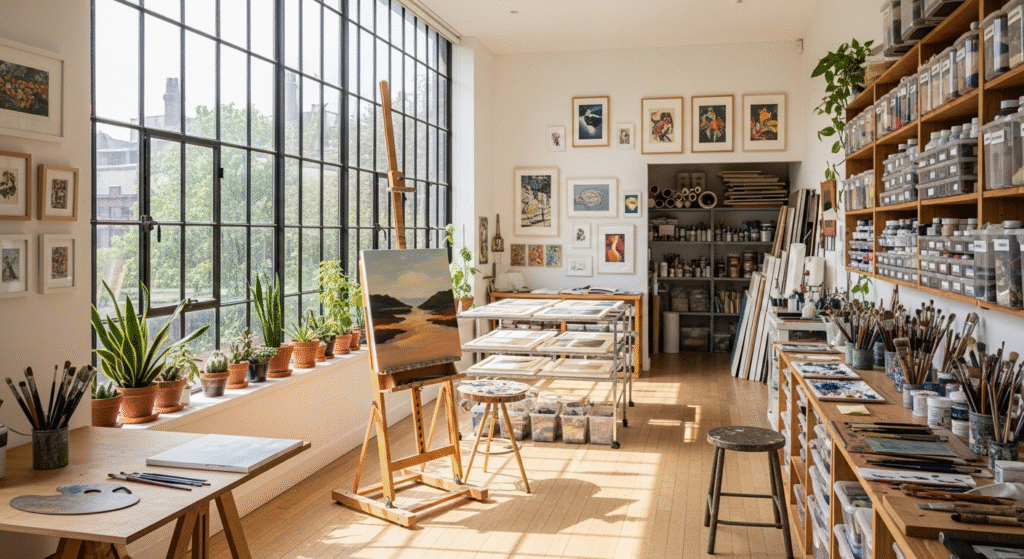
Part 1: The Foundation – Mindset & Environment
Setting Up Your “Flow” Environment
Your studio space directly impacts your productivity. Think of it as your creative laboratory—when it’s organized and inspiring, everything flows better. Here’s how to optimize your workspace:
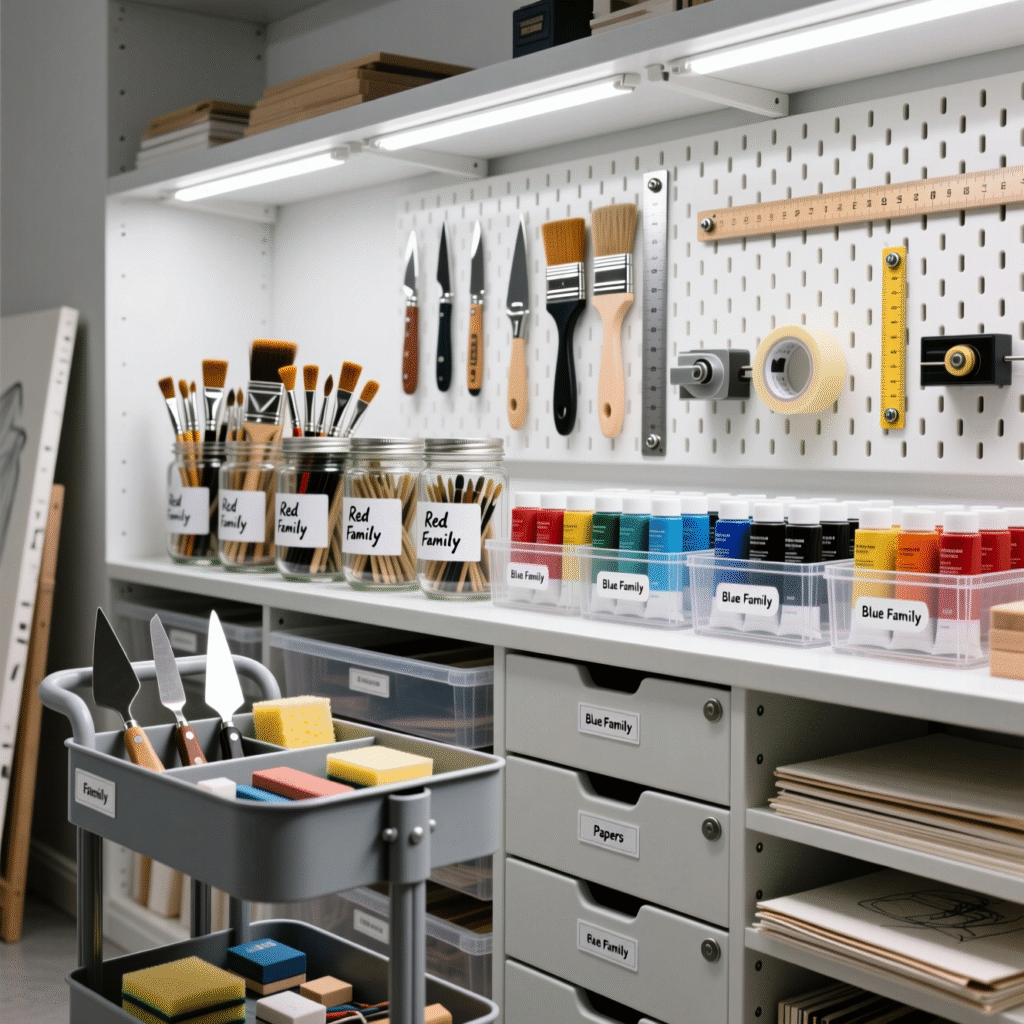
Physical Organization:
- Designate clear zones: Separate areas for active work, drying paintings, storage, and administrative tasks
- Lighting matters: Natural light is ideal, but invest in quality daylight bulbs for evening work
- Tools within reach: Organize your painting tools so you’re not breaking focus to hunt for brushes
- Minimize distractions: Put your phone in another room during focused work sessions
“The studio should be a sanctuary where the noise of the world fades and your inner creative voice grows louder.”
Digital Organization: For modern artists, digital clutter is just as problematic as physical mess. Create folder systems for reference images, commission details, and work-in-progress photos. Use cloud storage so you can access your files anywhere.
Setting Achievable Goals
One of the biggest productivity killers for artists is vague goals. “Get better at painting” won’t cut it. You need specific, measurable objectives that you can track.
The SMART Goal Framework for Artists:
- Specific: “Complete 12 watercolor landscapes” not “paint more”
- Measurable: “Post 3 times per week on Instagram” not “be more active on social media”
- Achievable: Consider your actual available time and energy
- Relevant: Align with your bigger vision (gallery show, commission work, personal growth)
- Time-bound: Set deadlines, even for personal projects
Break big goals into weekly and daily tasks. If your goal is preparing for a gallery exhibition, your weekly tasks might include completing two paintings, photographing finished work, and drafting artist statements. Daily tasks become manageable chunks: “sketch composition for painting #1” or “mix color palette for piece #2.”
Protecting Your Well-Being
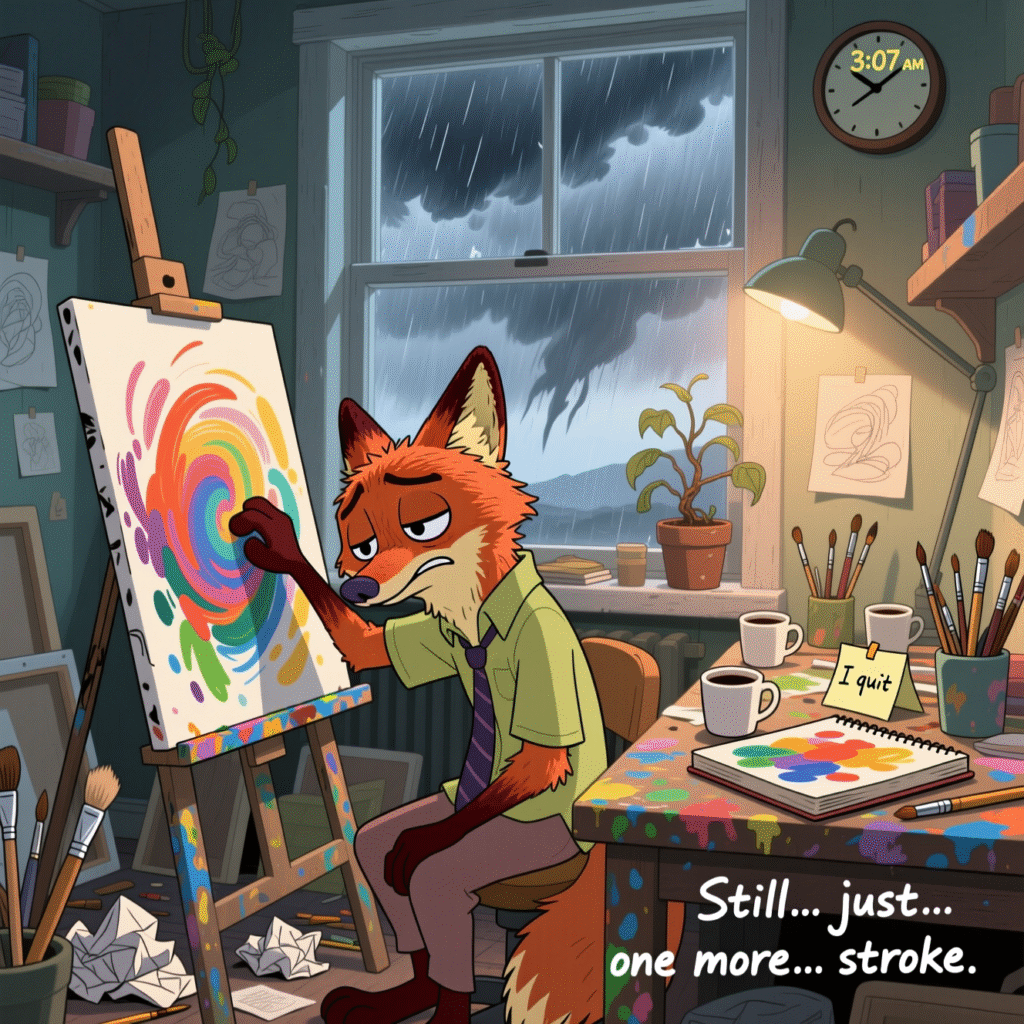
This is non-negotiable: you can’t be productive if you’re burned out. Artist burnout is real, and it often stems from pushing too hard without proper rest.
Essential Burnout Prevention Strategies:
- Set boundaries: Define your working hours and stick to them, especially if you work from home
- Schedule rest: Treat breaks as seriously as work time
- Recognize warning signs: Constant exhaustion, loss of enthusiasm, inability to make decisions, or creative blocks that last weeks
- Balance commissions with passion projects: If all your work is client-driven, you’ll lose touch with why you became an artist
Remember, improving your art skills happens through consistent practice, not exhausting yourself with unsustainable work marathons.
Part 2: Actionable Time Management Techniques for Productivity for Artists
Prioritize Your Tasks (Eat That Frog)
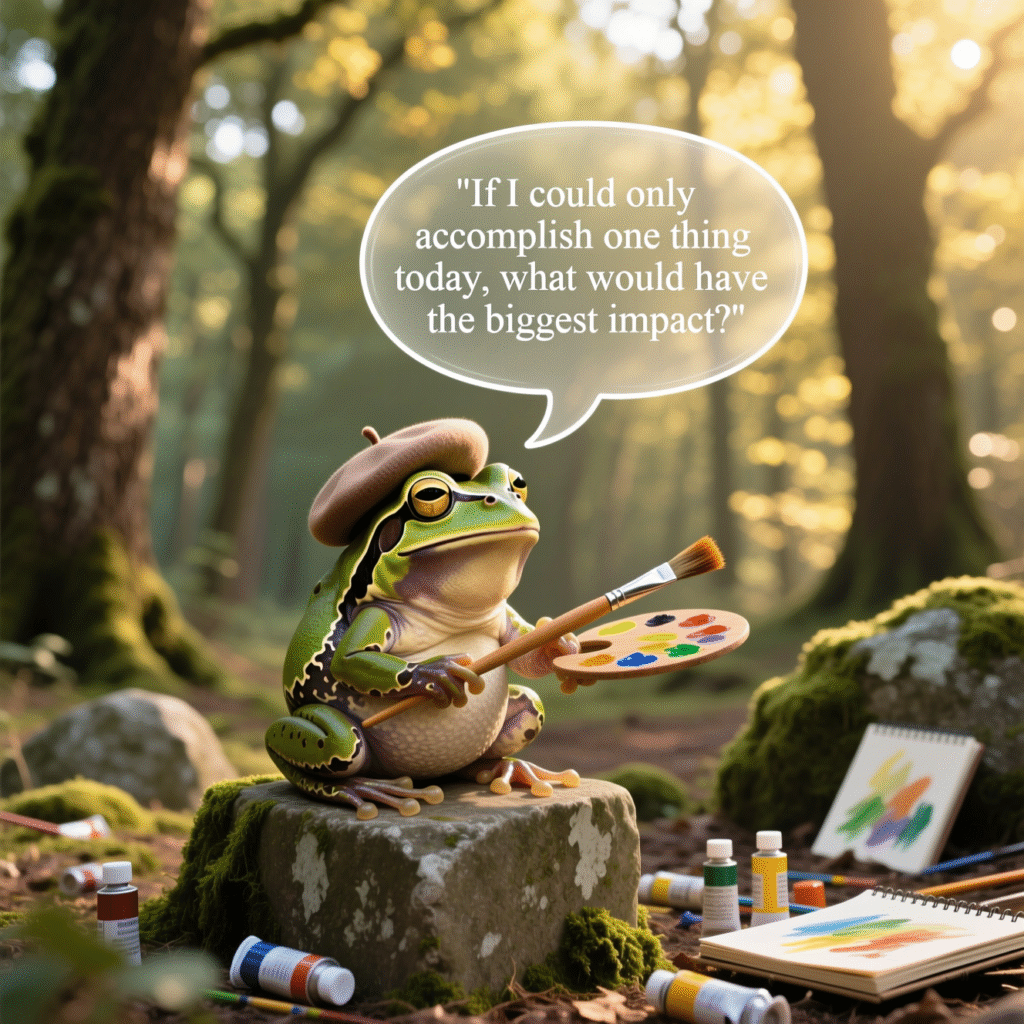
“Eat That Frog” is a technique popularized by Brian Tracy. The idea is simple: tackle your most difficult or important task first thing in the morning when your energy and willpower are highest.
For artists, your “frog” might be:
- Starting a challenging new composition
- Handling difficult client feedback
- Tackling the administrative work you’ve been avoiding
- Working on the technically demanding part of a painting
Why does this work? Once you’ve completed your most intimidating task, everything else feels easier. Plus, you protect your best creative energy for what matters most instead of wasting it on emails and social media.
How to identify your frog: Ask yourself “If I could only accomplish one thing today, what would have the biggest impact?” That’s your frog.
Master Your Focus (The Pomodoro Technique)
The Pomodoro Technique involves working in focused 25-minute intervals (called “pomodoros”) followed by 5-minute breaks. After four pomodoros, take a longer 15-30 minute break.
Why this works for artists:
- Reduces overwhelm: Large projects become “just work for 25 minutes”
- Combats procrastination: Anyone can focus for 25 minutes
- Protects creative flow: You work intensely without burning out
- Regular breaks prevent physical strain: Important for painters working on detailed techniques
Adapting Pomodoro for creative work: If you’re deep in flow state, don’t stop at 25 minutes—that’s the beauty of this technique. The timer is a minimum commitment, not a hard stop. But if you’re struggling or doing repetitive tasks (mixing colors, preparing surfaces), strict pomodoros work perfectly.
Schedule Your Creativity (Time Blocking & Task Batching)
Time Blocking means scheduling specific blocks of time for different types of work. Rather than working reactively (“I’ll paint when I feel like it”), you proactively protect time for creation.
Sample Artist’s Time Block Schedule:
| Time | Activity |
|---|---|
| 9:00 AM – 12:00 PM | Deep creative work (painting, drawing) |
| 12:00 PM – 1:00 PM | Lunch & rest |
| 1:00 PM – 2:00 PM | Administrative tasks (emails, invoicing) |
| 2:00 PM – 3:00 PM | Social media content creation |
| 3:00 PM – 5:00 PM | Secondary creative work (sketches, experiments) |
Task Batching takes this further by grouping similar tasks together. Instead of answering emails throughout the day (constantly breaking your focus), batch them into one or two specific time slots.
Tasks perfect for batching:
- Photographing multiple finished artworks at once
- Writing all your social media captions for the week
- Responding to commission inquiries
- Organizing and cleaning painting tools
- Mixing multiple colors for several paintings
Use Google Calendar or iCal to literally block out your time. Seeing your schedule visually helps you protect your creative blocks from getting eaten up by less important tasks.
The 4 Ds: A Powerful Prioritization Method
When faced with any task, apply the 4 Ds:
- Do: Tasks that are important and urgent—do them now
- Defer: Important but not urgent—schedule for later
- Delegate: Can someone else do this? Outsource if possible (bookkeeping, website updates)
- Delete: Not important or urgent—eliminate it entirely
Most artists struggle with “Delete.” We feel guilty saying no. But every time you say yes to something unimportant, you’re saying no to your actual creative work.
Part 3: Beating the Block & Staying Consistent
How to Overcome Creative Block Quickly
Every artist faces creative blocks. The difference between struggling artists and successful ones isn’t whether you get blocked—it’s how quickly you move through it.
Practical Strategies to Beat Creative Block:
- Change your medium temporarily: If you’re stuck on an oil painting, try watercolors or digital art for a day
- Use constraints creatively: Painting with a limited palette or working in a smaller format can spark new ideas
- Copy masters: Study works you admire and create study copies—not to plagiarize, but to understand technique
- Walk away: Sometimes the best thing you can do is rest. Go for a walk, visit a gallery, or engage with art inspiration sources
- Work on something “not serious”: Experimental pieces with zero pressure often unlock breakthrough ideas
- Shift to technical practice: If you can’t create finished work, practice specific skills like color mixing or brush techniques
The 10-Minute Rule: Commit to working for just 10 minutes. Usually, starting is the hardest part. Once you’re moving, momentum builds naturally. If after 10 minutes you’re still stuck, give yourself permission to stop guilt-free.
Video: Practical techniques for overcoming creative blocks from successful artists
Building a Daily Creative Habit
Consistency beats intensity. It’s better to paint for 30 minutes every day than to have one exhausting 8-hour session per week.
How to Build Unbreakable Creative Habits:
- Start embarrassingly small: Want to paint daily? Start with 10 minutes. You can always do more, but the goal is to show up consistently. Introduction to painting practices begin with simple exercises repeated regularly.
- Stack habits: Attach your new habit to an existing one. “After my morning coffee, I’ll sketch for 15 minutes.” This is called habit stacking and makes consistency much easier.
- Track your streak: Use a physical calendar and mark each day you complete your creative work. The visual reminder of your streak becomes motivating—you won’t want to break it.
- Prepare the night before: Set out your supplies, clear your workspace, and decide what you’ll work on. Eliminate decisions and friction that might stop you from starting.
- Embrace imperfect action: Not every day needs to produce a masterpiece. Some days you’re practicing technique, experimenting with color theory basics, or just maintaining your connection to the creative process.
Part 4: The Artist’s Productivity Toolkit
The right tools don’t create productivity—but they can support and amplify your systems. Here are the best digital tools for different artist needs:
Project Management & Organization
Trello ($0-$12.50/month)
- Perfect for: Visual thinkers who like to see everything at a glance
- Use it for: Managing multiple commissions, tracking progress on series, planning exhibitions
- Best feature: Card-based system that you can move through stages (Ideas → In Progress → Complete)
Asana ($0-$13.49/month)
- Perfect for: Detailed task tracking and collaboration
- Use it for: Complex projects with many steps, working with other artists or galleries
- Best feature: Timeline view for deadline management
Notion ($0-$10/month)
- Perfect for: Artists who want everything in one place
- Use it for: Combining notes, databases, task lists, inspiration boards, and wiki-style references
- Best feature: Incredible flexibility—create custom databases for tracking supplies, commission rates, or competition deadlines
Notes & Inspiration Management
Evernote ($0-$10.83/month)
- Perfect for: Capturing ideas on the go
- Use it for: Web clipping reference images, voice memos of ideas, organizing research
- Best feature: Powerful search that works even on handwritten notes in images
Pinterest (Free)
- Perfect for: Building mood boards and finding art inspiration
- Use it for: Collecting reference images, color palettes, compositional ideas
- Best feature: Discover similar content automatically
Time Management
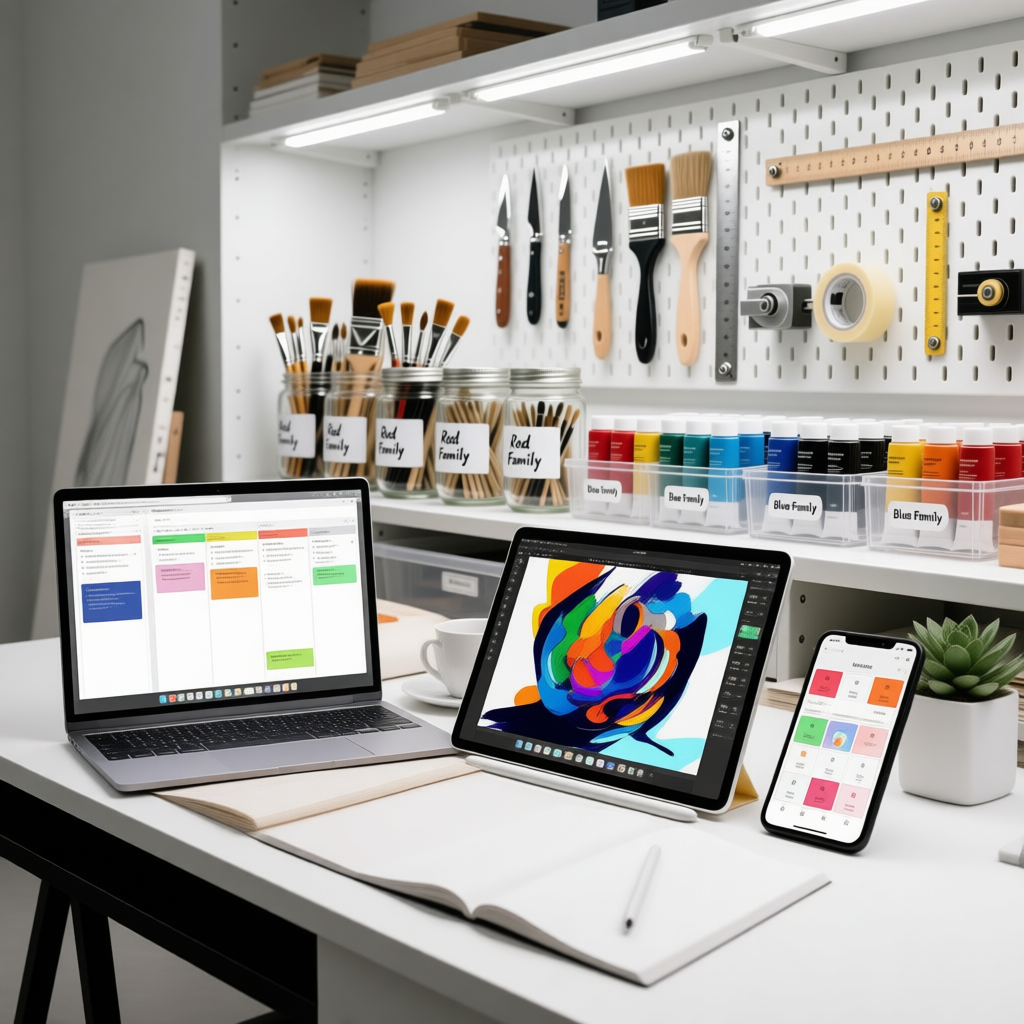
Google Calendar / iCal (Free)
- Perfect for: Time blocking and scheduling
- Use it for: Protecting creative time, setting reminders for deadlines, coordinating with clients
- Best feature: Color-coding different types of activities
Art-Specific Software
Adobe Photoshop / Illustrator ($54.99/month for both)
- Perfect for: Digital illustration, photo editing, print preparation
- Use it for: Creating digital artwork, preparing art for print-on-demand, editing photos of physical work
Procreate ($12.99 one-time)
- Perfect for: iPad-based digital painting
- Use it for: Sketching ideas anywhere, full digital paintings, study pieces
- Best feature: Intuitive interface that feels natural for traditional artists
Corel Painter ($429 one-time or $19.99/month)
- Perfect for: Digital painting that mimics traditional media
- Use it for: Creating works with realistic brush strokes and textures
- Best feature: Most realistic traditional media simulation
Conclusion: Your Path to Sustainable Productivity
Mastering productivity for artists isn’t about squeezing more hours out of your day or forcing yourself to work when you’re exhausted. It’s about creating systems that support your creative practice long-term. The techniques in this guide—from time blocking to the Pomodoro method, from studio organization to digital tools—work together to help you produce your best work consistently.
Remember: productivity is personal. Not every technique will work for you, and that’s okay. Experiment with these strategies, keep what works, and modify what doesn’t. The goal is to spend more time creating and less time feeling overwhelmed.
Start small. Pick one technique from this guide—maybe it’s time blocking your week or trying the Pomodoro technique tomorrow—and commit to testing it for two weeks. Small, consistent changes compound into major transformations in your creative practice.
What matters most isn’t perfection—it’s showing up for your art regularly, protecting your creative energy, and building a sustainable practice that supports both your craft and your wellbeing. Your future self (and your art) will thank you.
Frequently Asked Questions
What’s the best productivity app for artists?
There’s no single “best” app—it depends on your needs. For visual project management, Trello excels. If you want an all-in-one workspace, Notion is incredibly flexible. For capturing inspiration on the go, Pinterest or Evernote work well. Many artists use a combination: Notion for planning, Trello for tracking active commissions, and Google Calendar for time blocking.
How do I stay productive when I don’t feel inspired?
This is where systems save you. On uninspired days, shift to technical practice—work on color mixing exercises, study composition principles, or organize your studio. Inspiration often follows action rather than preceding it. The Pomodoro Technique is particularly helpful here—commit to just 25 focused minutes, and momentum usually builds naturally.
How long should I work on my art each day?
Quality matters more than quantity. For beginners, 30-60 minutes of focused daily practice beats sporadic marathon sessions. Professional artists typically work 4-6 hours of deep creative work per day, plus additional time for administrative tasks. What’s most important is consistency—it’s better to build a daily creative habit you can sustain than to burn out pushing too hard.
How can I be more productive while managing commissions?
Create systems for repetitive tasks: develop template emails for common questions, use a project management tool like Trello to track each commission’s status, and batch similar tasks (photographing all finished pieces at once, for example). Set clear boundaries with clients about response times and revision policies. Learn to manage commissions professionally from the start to prevent time-consuming misunderstandings later.
What should I do when I hit a creative block?
First, acknowledge that creative blocks are normal—every artist experiences them. Try changing your medium temporarily, working in a different painting style, or creating studies of work you admire. Physical movement helps too—take a walk or visit a gallery. If the block persists beyond a few days, it might signal burnout, and you may need actual rest rather than different work strategies.
How do I balance the business side of art with creative time?
This is where time blocking becomes essential. Protect specific blocks of time for deep creative work (typically morning when your energy is highest) and schedule administrative tasks for later. Use the “4 Ds” method: Do, Defer, Delegate, or Delete tasks based on urgency and importance. Many successful artists designate specific days for business tasks (invoicing, marketing, client communication) and other days purely for creation.
Is it worth investing in productivity tools and software?
Start with free options first—many excellent tools have free tiers that work perfectly well for most artists. Upgrade when you’ve actually outgrown the limitations, not because you think expensive tools will magically make you more productive. That said, art-specific software like Procreate ($12.99 one-time) or a good project management system can genuinely save hours of frustration, making them worthwhile investments.
How can I avoid burnout as an artist?
Set and enforce boundaries: define your working hours, take regular breaks, schedule at least one full day off per week, and balance client work with personal projects. Recognize warning signs early—persistent exhaustion, loss of enthusiasm, or creative blocks lasting weeks. Remember that rest isn’t laziness; it’s essential for sustainable creativity. Consider art for wellbeing practices to maintain balance.
Citations:
- Brian Tracy – Eat That Frog: 21 Great Ways to Stop Procrastinating and Get More Done in Less Time
- Francesco Cirillo – The Pomodoro Technique
- Cal Newport – Deep Work: Rules for Focused Success in a Distracted World
- Trello Project Management
- Asana Work Management Platform
- Notion All-in-One Workspace
- Evernote Note-Taking App
- Adobe Creative Cloud
- Procreate Digital Illustration App
- Corel Painter Digital Art Software

